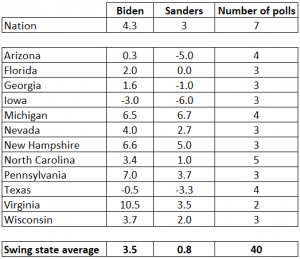In “What Is Next for the Democrats” at The Hill, Former DCCC Chairman Steve Israel writes, “The question for Democrats becomes what next? Should they keep driving down the twisting path of investigations and spurned subpoenas? Or should Democrats slam the brakes on their constitutional responsibility, two words Senate Republicans can no longer say with a straight face, to conduct real oversight of the administration?…The answer is to keep exposing the misdeeds of Trump, while opening a new front on the kitchen table issue of health care in Congress and on the campaign trail. It seems counterintuitive, but Democrats are in a decent, though imperfect, strategic political environment. They have thoroughly discredited acquittal…But harping on inappropriate, impeachable, and illegal behavior will not be enough for Democrats. They will have to exploit one of the greatest electoral vulnerabilities of Trump, which is health care. In a recent poll by Navigator Research, 56 percent of the voters surveyed trust Democrats in Congress over Trump when it comes to health care. This is the largest gap so far in this poll. A poll by Fox News Channel found 54 percent of voters disapprove of how the president is doing on the key issue of health care.”…Maintaining protections for people with preexisting conditions has been a relatively strong platform for Democrats. A poll by the Kaiser Foundation last November found that 62 percent of the public opposed the Supreme Court overturning the protection. In the same poll, conducted just before the 2018 midterm elections gave Democrats a House majority, 75 percent of Americans surveyed thought it was “very important” for the Affordable Care Act to maintain protections for people with preexisting conditions.”
From “What Swing Working-Class Voters in Battleground States Are Thinking” by Marcia Brown at The American Prospect: “Almost half of “persuadable” voters think that President Donald Trump has made no difference in their lives since his term began, according to new survey results of working-class communities in the battleground states of Arizona, Michigan, Minnesota, Pennsylvania, and Wisconsin released today by Working America, an advocacy arm of the AFL-CIO…The report also indicated that those who voted third-party in 2016 are now “more than twice as likely to pick the Democratic nominee as they are to stick with a third party.” Also notable is that 86 percent of those who supported Hillary Clinton in 2016 say they will support the 2020 Democratic nominee, but only 77 percent of those who voted for Trump in 2016 will vote for him again…The survey turned up pervasive cynicism toward the president’s tax plan passed in 2017. Working America says this shows “surprising potential for voter persuasion against him.” Even among the Republicans whom the group interviewed, only 40 percent had a positive view of Trump’s tax legislation. Writing Monday in the Financial Times, liberal pollster Stanley Greenberg noted that “slashing tax rates for corporations and the top 1 per cent was the last straw” for many such voters. The disfavor toward the tax cut crossed the urban-rural divide: “Regardless of the type of community where voters live,” the report states, “the tax law is overwhelmingly unpopular…In his column, Greenberg observed that “the shift against Mr. Trump among working people [in the 2018 midterm election] was three times stronger than the shift in the suburbs, where the Democrats were poised to flip seats.”
The Democratic response to Trump’s SOTU:
In Thomas B. Edsall’s New York Times column, “If Bernie Wins, Where Will He Take the Democratic Party?,” he writes, “The next step is the New Hampshire primary on Feb. 11, where Sanders currently has a strong 8.6 percentage point lead, according to RealClearPolitics. If Sanders wins New Hampshire, there will almost certainly be an establishment-led drive to block him from the nomination.” Edsall cites “Republican efforts to demonize Sanders, which are certain to start in earnest if he becomes the nominee,” and adds, “Sanders stands out among the leading Democratic presidential candidates in that none of the others have accumulated as many potentially debilitating liabilities as he has over 50 active years in politics…Sanders’s positioning on the far left has been crucial to mobilizing pluralities of Democratic primary and caucus voters. But many studies show that in general elections, the nomination of more extreme candidates has alienated moderates and driven up voting for the opposition — in this case the Republican Party…
However, notes Edsall, “Sanders’s ascendancy in the nomination fight places the Democratic Party in a double bind. Not only is he potentially a dangerously weak general election candidate but, if an Anybody-But-Bernie movement materializes and successfully defeats him at the convention, Sanders supporters — more than backers of any other major candidates — are likely to bolt on Election Day and vote for either a third-party candidate or even Trump (as many Sanders supporters did in 2016), or sit out the contest altogether. In 2016, more than 7 million votes were cast for third-party candidates, more than enough to have given the election to Hillary Clinton…A January 22-23 Emerson College survey asked Democratic primary voters “will you vote for the Democratic nominee even if it is not your candidate?” 87 percent of Joe Biden supporters said yes, as did 90 percent of those backing Elizabeth Warren and 86 percent of those aligned with Pete Buttigieg. 53 percent of Sanders supporters said yes, 16 percent said no, and 31 percent said they were undecided.”
On the other hand, Edsall adds, “There are election analysts, including a number of conservatives, who say that they believe that Sanders would be a credible nominee with a good chance of beating Trump.” He quotes Matthew Yglesias, who says “The Vermont senator is unique in combining an authentic, values-driven political philosophy with a surprisingly pragmatic, veteran-legislator approach to getting things done. This pairing makes him the enthusiastic favorite of non-Republicans who don’t necessarily love the Democratic Party, without genuinely threatening what’s important to partisan Democrats…At the end of the day, Sanders’s record is not nearly as scary as many establishment Democrats fear. His ‘revolution’ rhetoric doesn’t make sense to me, but he’s been an effective mayor and legislator for a long time” Edsall concludes, “Now it may be that the country is ready to elect as president a 78-year-old angry democratic socialist calling for revolution. But if I were a partisan whose top priority was to bring the Trump presidency to an end, I would not bank on it.”
Nate Silver shares some insights from FiveThirtyEight’s post-Iowa forecast: “Now that we finally have some clarity on Iowa’s results — with 86 percent of precincts reporting — we’ve turned our primary model back on, including its estimates of the potential fallout from Iowa…The model shows former Vice President Joe Biden’s chances of winning a majority of pledged delegates being halved — from 43 percent before Iowa to 21 percent now…Who gains from Biden’s decline? Well, a little bit of everyone. The model thinks Iowa was more good news than bad news for Sen. Bernie Sanders…His chances have advanced to 37 percent, from 31 percent before Iowa, making him the most likely person to achieve that majority…Pete Buttigieg’s chances are also up, to 6 percent from 4 percent before…Buttigieg still has his work cut out for him in building a broader coalition; it’s going to require a big bounce in states and among demographic groups where the former mayor is not currently strong…Sen. Elizabeth Warren’s majority chances are also slightly up, according to our model, having improved to 10 percent from 5 percent before. That’s because in a more chaotic field, with at least one of the front-runners (Biden) potentially falling back into the pack, her roughly 15 percent of the vote in national polls could eventually give her some opportunities, even though none of the next three states look especially promising for her.”
Janell Ross reports “Tidal wave of voter suppression’ washes over states, lawyer says” at nbcnews.com: “States across the country have, in the wake of the Supreme Court’s 2013 decision striking down part of the Voting Rights Act, moved swiftly and repeatedly to reshape almost every element of voting. Lawmakers are using a variety of race and age-neutral measures with explanations as pragmatic as cost and as prudent as election security. Now, with Election Day less than 10 months away, a range of lawsuits are pending or have recently been resolved challenging what Marc Elias, a lawyer working for the Democratic Congressional Campaign Committee, described as “nothing short of a tidal wave” of voter suppression targeting black and young voters…“We are seeing stark levels of voter suppression efforts,” said Kristen Clarke, president and executive director of the National Lawyers’ Committee for Civil Rights Under Law said. “In a post-Shelby world, the burden falls to citizens and civil rights groups to monitor and challenge all that is going on. But what’s really made this worse is what’s happening at the Justice Department. “…States are engaging in aggressive voter roll purges, polling site closures and uneven voting resource allocations that, in some cases, violate the law, Clarke said.”
Ross provides detailed updates on current voter suppression campaigns underway in a number of states: “In Texas, officials in mostly white Waller County, citing cost concerns, announced that they would not make an early voting site available on the campus of a historically black university. Then the state passed a law effectively requiring other communities to take similar action…A Tennessee law threatens third-party groups that register citizens to vote with criminal penalties if they make mistakes on forms or the forms arrive incomplete. The state’s governor, a Republican, said the law will make elections fairer…And in Florida, state lawmakers overrode the results of a ballot initiative restoring voting rights to felons who have completed their sentences. Lawmakers who opposed the initiative insisted it was up to them to define what constitutes a completed sentence…months after more than 1.6 million Florida residents with felony convictions regained the right to vote, Florida’s Republican-controlled Legislatureimplemented a law requiring that individuals pay fines and fees associated with their convictions before being able to vote.”






